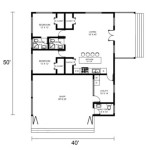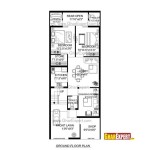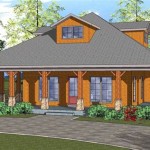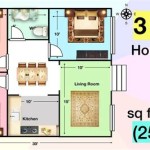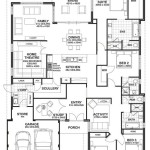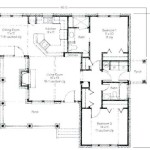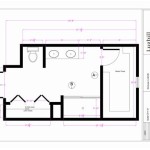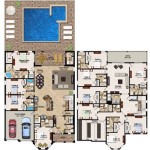Exploring the Charm and Practicality of 1-Story Farmhouse Floor Plans
The allure of the farmhouse style continues to captivate homeowners, blending rustic charm with modern convenience. Within this architectural style, the 1-story farmhouse floor plan stands out for its accessibility, practicality, and inherent aesthetic appeal. These designs prioritize ease of living, making them suitable for a wide range of homeowners, from those with mobility concerns to growing families and empty nesters. This article delves into the key features, advantages, and considerations associated with 1-story farmhouse floor plans, providing a comprehensive understanding of their enduring popularity.
The Defining Characteristics of a 1-Story Farmhouse
Several elements define a 1-story farmhouse floor plan, contributing to its distinctive ambiance and functionality. These characteristics often pay homage to the traditional farmhouse while incorporating contemporary design principles.
First and foremost, the horizontal orientation is paramount. All living spaces, including bedrooms, bathrooms, kitchen, and living areas, are located on a single level. This eliminates the need for stairs, promoting accessibility and creating a sense of openness throughout the home. This layout is particularly beneficial for individuals with mobility limitations or those who prefer the convenience of a single-story living environment.
Another defining element is the emphasis on open-concept living spaces. Kitchens often flow seamlessly into dining areas and living rooms, fostering a sense of connectedness and encouraging interaction among family members and guests. This open layout also allows for better natural light penetration, creating a brighter and more inviting atmosphere.
The inclusion of a spacious front porch is a hallmark of the farmhouse style. These porches serve as an outdoor extension of the living space, providing a welcoming area for relaxation, socializing, and enjoying the surrounding landscape. Porches often feature comfortable seating, such as rocking chairs or porch swings, further enhancing their appeal and functionality.
Exterior materials typically reflect the rustic aesthetic of the farmhouse style. Common choices include wood siding, board and batten, and stone accents. These materials contribute to the home's natural and timeless appearance, blending seamlessly with the surrounding environment. The roof design often incorporates gabled or hipped roofs, further enhancing the architectural character of the farmhouse.
Interior design elements often incorporate natural materials, such as wood flooring, exposed beams, and shiplap walls. These elements add warmth, texture, and character to the home's interior, creating a cozy and inviting atmosphere. Fireplaces, often clad in stone or brick, serve as focal points in living rooms, providing both warmth and visual appeal.
Large windows are also a key feature, maximizing natural light and providing views of the surrounding landscape. This connection to the outdoors is a defining characteristic of the farmhouse style, creating a sense of tranquility and harmony.
Advantages of Choosing a 1-Story Farmhouse Floor Plan
Selecting a 1-story farmhouse floor plan offers several compelling advantages that cater to various lifestyle needs and preferences.
Enhanced Accessibility is a primary benefit. The absence of stairs makes the home accessible to individuals of all ages and abilities. This is particularly important for elderly homeowners or those with mobility challenges who want to age in place comfortably. A single-story layout eliminates the risk of falls and allows for easier movement throughout the home.
Improved Energy Efficiency can also be achieved with a 1-story design. With all living spaces on a single level, heating and cooling systems can operate more efficiently, reducing energy consumption and lowering utility bills. The absence of multiple stories also minimizes heat loss through the roof, further contributing to energy savings. Proper insulation and energy-efficient windows are also important factors in maximizing energy efficiency in a 1-story farmhouse.
Simplified Maintenance is another notable advantage. Cleaning and maintaining a single-story home is generally easier than maintaining a multi-story home. Tasks such as window cleaning, gutter maintenance, and roof repairs are simplified by the absence of multiple levels. This can save homeowners time, effort, and money in the long run.
Increased Safety is also a consideration. In the event of a fire or other emergency, escaping from a 1-story home is generally easier and faster than escaping from a multi-story home. This can be particularly important for families with young children or elderly individuals who may have difficulty navigating stairs.
Enhanced Connection to the Outdoors is a characteristic often emphasized in 1-story farmhouse designs. With all living spaces on a single level, it is easier to create seamless transitions between indoor and outdoor areas. Large windows, sliding doors, and spacious porches allow homeowners to enjoy the surrounding landscape and connect with nature. This can contribute to a sense of well-being and promote a healthier lifestyle.
Greater Flexibility in Design is often possible with 1-story plans. While confined to a single level, the design can often expand horizontally allowing for creative layouts and adaptable spaces. Many homeowners find they can customize the layout to perfectly suit their needs.
Key Considerations When Planning a 1-Story Farmhouse
While 1-story farmhouse floor plans offer numerous benefits, it is essential to consider certain factors during the planning and design process. Careful consideration of these aspects will help ensure that the final design meets the homeowner's needs and preferences.
Lot Size and Orientation is a critical consideration. A 1-story home typically requires a larger lot than a multi-story home with the same square footage. This is because all living spaces are located on a single level, requiring a larger footprint. The orientation of the lot is also important, as it can affect the amount of natural light that enters the home and the overall energy efficiency. Consider the direction of the sun, prevailing winds, and any existing trees or landscaping when determining the optimal orientation for the home.
Privacy Considerations are important, especially in densely populated areas. With all living spaces on a single level, it is important to carefully plan the placement of windows and doors to ensure adequate privacy. Landscaping, such as trees and shrubs, can also be used to create a natural privacy screen. Consider the proximity of neighboring homes and the level of privacy desired when designing the layout of the home.
Storage Space is another crucial consideration. In a 1-story home, storage space may be limited compared to a multi-story home. It is important to carefully plan for adequate storage space throughout the home, including closets, cabinets, and potentially an unfinished attic or basement. Consider incorporating built-in storage solutions, such as shelves and drawers, to maximize space utilization. A well-designed layout should anticipate storage needs based on lifestyle and possessions.
Future Needs and Adaptability should be considered when designing a 1-story farmhouse floor plan. Think about how the home may need to adapt to changing needs in the future, such as the addition of family members or the need for assisted living. Consider incorporating flexible spaces that can be easily converted to meet different needs over time. This may include a spare bedroom that can be used as a home office or a flexible living space that can be divided into multiple rooms. Thinking ahead can ensure the home remains functional and comfortable for years to come.
Cost Considerations are essential. Building a 1-story home can sometimes be more expensive per square foot than building a multi-story home. This is because the foundation and roof area are typically larger for a 1-story home with the same square footage. However, the overall cost may be offset by lower heating and cooling costs, as well as reduced maintenance expenses. Obtain multiple bids from contractors and carefully review the budget to ensure that the project is financially feasible.
Accessibility Features must be integrated thoughtfully if accessibility is a primary concern. Wider doorways and hallways can facilitate easier wheelchair navigation. Roll-in showers and grab bars in bathrooms can enhance safety and independence. Lever-style door handles are easier to operate than traditional doorknobs. Consider these features during the design phase to create a truly accessible living environment.

4 Bedroom 1 Story Modern Farmhouse Style Plan With Outdoor Living Area And Bonus Room Westchester Craftsman House Plans

Single Story Farmhouse Plans Blog Eplans Com

1 Story Modern Farmhouse House Plan Vandyke Plans Style

One Story Modern Farmhouse Plan With Open Concept Living 51829hz Architectural Designs House Plans

House Plan 9279 00004 Modern Farmhouse 2 677 Square Feet 4 Bedrooms 5 Bathrooms Floor Plans Bedroom

The Ultimate Guide To Modern Farmhouses Houseplans Blog Com

Small Farmhouse Plans Fit For Fall Blog Eplans Com

1 Story Farmhouse House Plan Fair Acres Plans Cottage Style Blueprints

25 Gorgeous Farmhouse Plans For Your Dream Homestead House

16 Farmhouse Floor Plans Modern Single 2 Story

